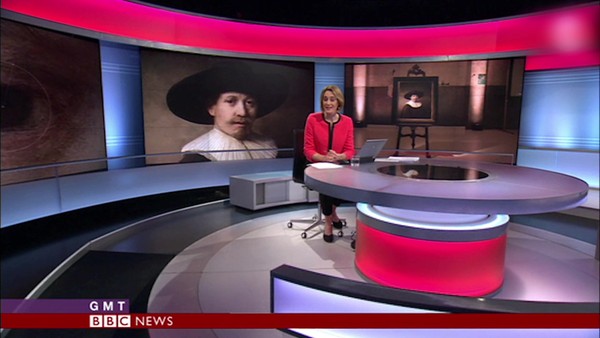Entertainment > Brand Experience
THE NEXT REMBRANDT
J. WALTER THOMPSON AMSTERDAM, Amsterdam / ING BANK / 2016
Awards:

Overview
Credits
OVERVIEW
CampaignDescription
347 years after his death, one of the greatest Masters of all time is brought back to life to create one more masterpiece. But this time, data is the painter and technology the brush: The Next Rembrandt.
The Next Rembrandt is a 3D printed painting made completely out of Rembrandt-data. All of his 346 paintings were analysed using hi-res 3D scans and digital files upscaled by a deep learning algorithm.
Facial recognition and machine learning software was designed to understand Rembrandt’s style and use those learnings to generate new facial features, which were assembled based on his use of geometric proportions.
Finally, a height map was created to mimic Rembrandt’s brushstrokes. The file was brought to life through an advanced 3D printer that printed 13 layers of paint based UV-ink.
The Next Rembrandt was unveiled and exhibited in Amsterdam on the 5th of April.
Execution
To make sure we engaged as many people as possible, we started by inviting various experts from the art and tech world, the international press and the general public to the unveiling and exhibition of The Next Rembrandt in Amsterdam.
A modern art gallery was transformed into an exhibition space with big screens with the actual algorithms at work, playing behind the easel with the painting, made out of zero’s and ones.
This special gallery was the place where the conversation started.
Via an online launch film, people all over the world were invited to visit nextrembrandt.com, where they could dive deeper into the process of creating the digital painting.
And a 20 minute documentary added another layer to the campaign focussing on the battle of man versus machine. Inviting people to join the global conversation about where data and technology can take us.
About ING’s innovation defying imagination.
Outcome
People from all over the world came to experience the unveiling and exhibition in Amsterdam. There the global conversation started.
- The Next Rembrandt was global trending topic, reporting 10 million Twitter impressions on unveiling-day.
- Over 1.400 articles (and counting) were written.
- All major news networks covered the unveiling, commenting on its meaning for future innovations.
- Globally over 1.8 billion media impressions.
- Earned media value: 12.5 milllion euro.
- On launch day Fortune Magazine reported an increase in stock value for ING (ING ^1.22%) and partner Microsoft (MSFT ^ 0.49%).
- After launch, Google reported ING’s Search Interest increased by 61.29% and Microsoft by 20%.
Next to the ongoing global conversation about the meaning for our industry and the future of creativity, there was another fundamental result: the technology developed for The Next Rembrandt is now used for the restauration of damaged and partially lost Masterpieces.
Relevancy
As a global bank, ING has been focussing on innovation as the way forward.
The Next Rembrandt brings data and technology to a world that’s riddled with tradition, rather than innovation: ING’s sponsorship of Dutch arts and culture.
The Next Rembrandt is a piece of content that takes perhaps the highest form of creativity – fine art – and demonstrates how it can be beautifully re-born with simple zeros and ones. And be brought to live on a 3D printer.
Building ING’s reputation as one of the world’s most innovative banks. And raising some provocative questions for the world to consider…
Strategy
If you want to engage the world, if you want to get the world talking about a piece of branded content, you have to go beyond existing boundaries.
You have to defy imagination.
The Next Rembrandt brings back to life the Master of Shadow and Light. But this time, data is the painter and technology the brush.
We dove deep into Rembrandt’s body of work, analysing all of his 346 paintings on a pixel by pixel basis. Statistical and demographical data were used to determine the subject of the painting.
Facial recognition software was designed to create the new portrait, based on the data of over 11 billion pixels.
A highly advanced 3D printer brought the digital file to life.
Leaving us with a controversial and engaging piece of branded content, that was unveiled and exhibited in Amsterdam to start a conversation about where data and technology can take us.
Synopsis
ING, a Dutch multinational banking group, has been building its credentials as an innovative bank.
It has introduced many innovative solutions to empower its clients. From the introduction of fingerprint log-in to the introduction of twyp, a free app that you can use to transfer money to friends.
Also, for many years ING has been supporting Dutch arts and culture - a world that’s riddled with tradition, rather than innovation – and so ‘art’ became the natural arena for this new work.
Main objective of The Next Rembrandt was to use data and technology in a way that engages people with the ING brand, to create a brand experience to would spark a global conversation about where data and technology can take us. In order to build one of the most innovative bank brands in the world.
More Entries from New Technology Brand Experience in Entertainment
24 items
More Entries from J. WALTER THOMPSON AMSTERDAM
24 items


















